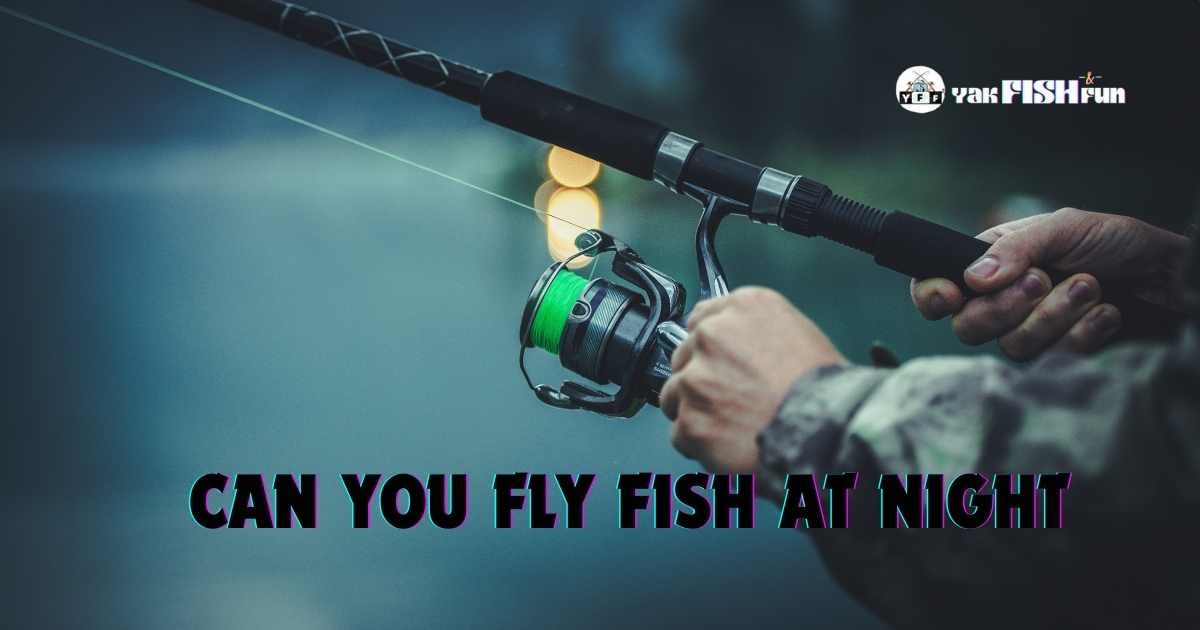Fly fishing is often associated with the tranquil early morning hours or the serene moments before dusk, but have you ever considered casting your line under the cover of darkness?
And the answer is – Yes, you can fly fish at night. Many anglers find night fly fishing rewarding and productive.
Fly fishing at night offers a unique experience and different challenges. Darkness changes the behavior of fish, often making them more active and less cautious. This creates excellent opportunities for catching larger fish. So, anglers need to adjust their techniques and use specific equipment like glow-in-the-dark flies and headlamps.
In this article, we will delve into the intriguing world of night fly fishing, exploring its feasibility, the specialized techniques required, and the potential benefits it holds for avid anglers.
Table of Contents

Can You Fly Fish At Night
Fly fishing at night offers a unique and rewarding experience. Anglers can enjoy quieter waters and potentially catch more fish. It’s essential to use appropriate gear and lighting for safety and effectiveness.
Fly fishing at night is an exhilarating experience. The serenity, the cool air, and the different species of fish create a unique adventure. But is it possible and effective to fly fish under the stars?
Advantages Of Night Fly Fishing
Fly fishing at night offers several benefits. Here’s why you might want to try it:
- Less competition: Fewer anglers are out, giving you more space.
- Cooler temperatures: Fish are more active in cooler, evening temperatures.
- Unique species: Some fish, like catfish, are more active at night.
Challenges Of Night Fly Fishing
While the night offers unique benefits, it also presents challenges. Let’s explore these hurdles:
- Limited visibility: Harder to see your line and surroundings.
- Safety concerns: Increased risk of accidents in the dark.
- Insect activity: Bugs can be more active, causing distractions.
Best Times For Night Fly Fishing
Choosing the right time is crucial for a successful night fly fishing trip. Here are some ideal times:
- Twilight hours: Just after sunset or before sunrise.
- Full moon nights: Better visibility from natural light.
- Calm weather: Less wind and stable conditions.
Essential Gear For Night Fly Fishing
Having the right gear can make or break your night fishing experience. Consider these essentials:
- Headlamp: Provides hands-free illumination.
- Reflective clothing: Enhances visibility and safety.
- Glow-in-the-dark flies: Easier for fish to see your bait.
Safety Tips For Night Fly Fishing
Staying safe is paramount when fishing at night. Here are some tips to ensure your safety:
- Buddy system: Always fish with a partner.
- Know the area: Familiarize yourself with the fishing spot during the day.
- First-aid kit: Be prepared for minor injuries or mishaps.
Ideal Locations For Night Fly Fishing
Finding the right spot can significantly affect your success. Here are some top locations:
- Still waters: Lakes and ponds where fish come closer to shore.
- Shallow rivers: Easier to navigate and fish are more accessible.
- Near structures: Docks and piers where fish gather.
Techniques For Successful Night Fly Fishing
Certain techniques can boost your chances of catching fish at night. Here’s what to focus on:
- Slow retrieval: Mimics the natural movement of prey in low light.
- Surface flies: Attract fish feeding near the top.
- Stealth approach: Minimize noise to avoid spooking fish.
Preparation For Fly Fishing At Night – What You Need To Know
Fly fishing at night offers a unique and thrilling experience for anglers. Proper preparation ensures safety and success under the moonlight. Equip yourself with the right gear, including headlamps and reflective clothing, for an enjoyable nighttime adventure.
Fly fishing at night offers a unique and thrilling experience. The quiet and calm of the night can enhance your connection with nature and increase your chances of catching fish. But before you head out, you need to be well-prepared to ensure a successful and safe outing.
Proper Gear For Night Fishing
Choosing the right gear is crucial for night fishing. Here’s what you’ll need:
- Headlamp with Red Light Mode: Keeps your hands free and preserves your night vision.
- Glow-in-the-Dark Indicators: This helps you track your line in low-light conditions.
- High-Visibility Fly Line: Makes it easier to see your casts.
- Warm Clothing: Even summer nights can be chilly.
- Bug Spray: Keeps those pesky insects at bay.
Understanding Fish Behavior At Night
Fish behave differently at night. Knowing these patterns will increase your success.
Most fish are more active at night due to lower temperatures and less light. They often move to shallower waters to feed. Predatory fish like bass and trout use the darkness to their advantage, making them easier to catch.
Safety Precautions
Night fishing requires additional safety measures. Here’s what you should consider:
- Buddy System: Always fish with a partner for increased safety.
- Life Jacket: Essential if you’re wading or fishing from a boat.
- First Aid Kit: Be prepared for any minor injuries.
- Emergency Whistle: Useful for signaling if you need help.
- Check Weather Forecast: Avoid fishing in bad weather conditions.
Choosing The Right Location
Selecting a good spot is key to a successful night fishing trip.
Look for areas with good access and minimal obstacles. Familiarity with the location is beneficial. Ponds, lakes, and slow-moving rivers are ideal. Avoid areas with strong currents or dense vegetation, which can be hazardous at night.
Fly Selection
Fly selection changes at night. Here’s what you should consider:
- Larger Flies: Easier for fish to detect in low light.
- Dark Colors: Create a strong silhouette against the night sky.
- Noisy Flies: Attract fish through vibrations and noise.
- Streamers: Mimic small fish and are effective for night fishing.
- Surface Flies: Useful for targeting fish feeding on the surface.
By preparing adequately and understanding the nuances of night fishing, you can make the most out of your nocturnal fly fishing adventures.
Advantages Of Fly Fishing At Night
Fly fishing at night offers a serene experience with fewer crowds and increased chances of catching nocturnal fish. Cooler temperatures can also make fish more active and responsive. Enjoy the tranquility and unique challenges of nighttime angling.
Fly fishing at night offers a distinct and thrilling experience. As the sun sets and darkness falls, a different world emerges on the water. This unique setting provides several advantages that daytime anglers might not encounter.
Cooler Temperatures
Fishing at night means escaping the sun’s intense heat. This can make the experience more comfortable and enjoyable.
- Reduced heat: Night fishing provides a break from the sun’s harsh rays.
- Comfortable conditions: Cooler temperatures can make the experience more pleasant for anglers.
Less Competition
With fewer people out on the water, fly fishing at night can be a more peaceful activity.
- Solitude: Night fishing often means fewer anglers around.
- Prime spots: More access to the best fishing locations without the crowds.
Active Fish Behavior
Fish tend to be more active after dark, offering better chances for a successful catch.
Many species feed more aggressively at night. This increases your chances of landing a catch. Fish may be less wary of artificial lures. This can make them easier to catch.
Unique Challenges
Fly fishing at night presents challenges that can enhance your skills.
- Navigation: Angling in the dark sharpens your navigation abilities.
- Casting precision: Limited visibility requires more precise casting techniques.
Enhanced Sensory Experience
Night fishing heightens your senses, making the experience more immersive.
- Sounds: The quiet of night amplifies the sounds of nature.
- Visuals: Moonlight and stars create a serene and picturesque environment.
Special Equipment
Fishing at night lets you use specialized gear and techniques.
- Glow-in-the-dark lures: These can attract fish more effectively in low light.
- Night vision gear: Helpful for spotting fish and navigating safely.
Less Pressure On Fish
Angling at night can reduce stress on fish populations.
- Reduced angler impact: Fewer people fishing means less pressure on local fish.
- Sustainable practice: Night fishing can help maintain healthy fish populations.
Finding The Right Location For Fly Fishing At Night
Night fly fishing offers a unique experience, requiring the right location for success. Seek areas with calm waters and ample fish activity. Focus on safety and familiar territories to enhance your nighttime adventure.
Fly fishing at night can be an exhilarating experience, but it requires careful planning. Selecting the right location is crucial for success. Understanding the unique characteristics of nighttime fly fishing helps ensure a memorable outing.
Proximity To Light Sources
Fishing near light sources can increase your chances of success. Here are some tips for selecting such spots:
- Docks and Piers: These areas often have lights that attract fish.
- Bridges: Well-lit bridges can create feeding zones for fish.
- Urban Areas: City lights can illuminate water, drawing fish closer to the surface.
Water Bodies With Known Activity
Choosing water bodies known for their fish activity at night is essential. Not all water bodies are ideal for nighttime fishing:
- Rivers and Streams: These often have moving water, which can be more productive.
- Lakes: Large lakes with known fish populations can be excellent spots.
- Coastal Areas: Saltwater fly fishing near the shore can yield great results.
Accessibility And Safety
Ensuring the location is accessible and safe is paramount. Consider these points when planning your trip:
- Well-Maintained Paths: Ensure paths to the fishing spot are safe and easy to navigate.
- Emergency Exits: Know the nearest exits in case of emergencies.
- Mobile Signal: Ensure your phone works in the area for safety reasons.
Local Regulations
Understanding local fishing regulations can save you from fines and penalties. Always check the rules before heading out:
- Permits: Ensure you have the necessary fishing permits.
- Catch Limits: Be aware of the local catch limits and species restrictions.
- Night Fishing Rules: Some areas may have specific rules for night fishing.
Environmental Factors
Environmental factors play a critical role in fly fishing at night. Here are some key considerations:
- Moon Phases: Full moons can provide better visibility and attract more fish.
- Weather Conditions: Clear nights are ideal, while stormy weather can be dangerous.
- Water Temperature: Fish activity can vary with water temperature changes at night.
The Best Bait & Lures For Nighttime Fly Fishing
Fly fishing at night can be highly effective with the right bait and lures. Glow-in-the-dark flies and streamers attract fish in low light. Use patterns that mimic nocturnal insects for the best results.
Fly fishing at night can be an exhilarating experience, adding a new dimension to your angling adventures. To make the most of your nocturnal fishing, choosing the right bait and lures is essential. Here’s what you need to know.
Streamers
Streamers are highly effective in low-light conditions. Fish rely more on movement than sight at night, making streamers an excellent choice.
- Size matters: Larger streamers stand out in the dark.
- Colors to consider: Black or dark colors create a strong silhouette.
- Action and movement: Opt for streamers with erratic motions to mimic prey.
Poppers And Surface Lures
Surface lures create commotion on the water’s surface, attracting fish through sound and vibration.
Poppers and surface lures work wonders at night. These lures create ripples and noise, drawing fish to the surface.
- Popper types: Choose those with a concave face for maximum splash.
- Color selection: Black or dark colors work best in the dark.
- Retrieve technique: Use a slow, steady retrieve to mimic struggling prey.
Nymphs
Nymphs, mimicking aquatic insects, are another excellent option for nighttime fly fishing.
- Weighted nymphs: Help you reach deeper waters where fish may be lurking.
- Size and shape: Choose larger nymphs to make them more noticeable.
- Glow-in-the-dark options: Some nymphs come with glow features, increasing visibility.
Soft Hackles
Soft hackles are versatile and effective in various conditions, including nighttime.
Soft hackles can be very effective at night. They mimic emerging insects and attract fish with their subtle movements.
- Material choice: Opt for those with natural materials for better movement.
- Size selection: Larger soft hackles are easier for fish to detect.
- Color: Darker colors create a more prominent silhouette in low light.
Glow-in-the-dark Flies
Glow-in-the-dark flies can be a game-changer. These flies charge up with light and glow in the dark, making them highly visible.
- Types available: Streamers, nymphs, and dry flies all come in glow-in-the-dark versions.
- Charging method: Use a flashlight or UV light to charge them.
- Visibility: They remain visible longer, increasing your chances of a catch.
Scented Baits
Although not traditional in fly fishing, scented baits can attract fish through their sense of smell.
Using scented baits can boost your chances, especially when visibility is low.
- Types of scents: Garlic, anise, and shrimp are popular choices.
- Application: Apply a small amount to your fly to enhance its appeal.
- Effectiveness: Fish may be drawn to the scent, even if they can’t see the bait clearly.
Choosing the right bait and lures for nighttime fly fishing can make a significant difference. Experiment with these options to find what works best for you.
Tips And Tricks For Successful Fly Fishing At Night
Fly fishing at night offers a unique challenge and rewarding experience. Use glow-in-the-dark flies and focus on quieter waters. Carry a headlamp for better visibility and safety.
Fly fishing at night offers a unique and rewarding experience. The serene environment, coupled with the challenge of fishing in low light, can be both thrilling and productive. To ensure a successful outing, it’s essential to arm yourself with the right knowledge and techniques.
Choosing The Right Gear
Using the right equipment can make a big difference:
- Headlamp with a red light: Helps maintain night vision while tying knots.
- Glow-in-the-dark strike indicators: Makes it easier to detect bites.
- Reflective tape on gear: Ensures you don’t lose any equipment in the dark.
Understanding Fish Behavior
Fish behave differently at night. Knowing these patterns can improve your chances of success:
- Feeding habits: Many species feed more actively during low light.
- Movement patterns: Fish tend to move closer to the shore at night.
- Preferred locations: Look for areas with structures like rocks or submerged logs.
Safety Precautions
Staying safe is paramount when fishing at night. Here are some key tips:
- Always fish with a buddy: Ensures help is available in case of emergencies.
- Familiarize yourself with the area: Avoid getting lost or encountering unexpected hazards.
- Wear a life jacket: Essential for safety, especially when wading in unfamiliar waters.
Casting Techniques
Proper casting is crucial in low light conditions:
- Use short casts: Easier to control and less likely to tangle.
- Practice your casting: Familiarity with your equipment helps in the dark.
- Focus on smooth movements: Reduces the risk of spooking fish.
Best Flies To Use
Selecting the right flies can increase your catch rate:
- Larger, darker flies: More visible in low light conditions.
- Streamers and poppers: Mimic the movement of prey more effectively at night.
- Scented flies: Attract fish through smell, compensating for low visibility.
Handling And Releasing Fish
Handling fish properly ensures their survival:
- Wet your hands: Prevents removing the fish’s protective slime.
- Use barbless hooks: Easier to remove and cause less injury.
- Release fish gently: Return them to the water with minimal stress.
What Time Of Day Is Best For Fly Fishing?
Early morning and late evening are best for fly fishing. Fish are more active during these cooler times.
Can I Catch Trout At Night?
Yes, you can catch trout at night. Trout are active after dark, especially in summer. Use glow-in-the-dark lures or bait.
Bottom Line
Fly fishing at night offers new opportunities for anglers. Although it has challenges like low visibility and needing special gear, the rewards are worth it. Fish are often more active after sunset, making night fishing a unique and peaceful experience. By learning about nocturnal fish behavior, choosing the right gear, and improving your night fishing skills, you can enjoy the benefits of fly fishing in the dark. So, if you’re seeking a new adventure or want to improve your fishing, try fly fishing under the stars.


